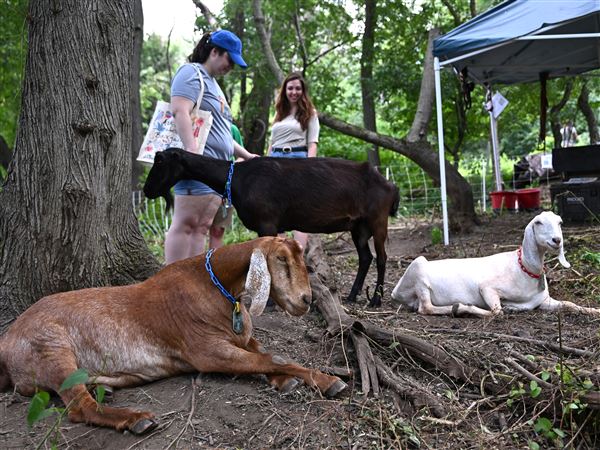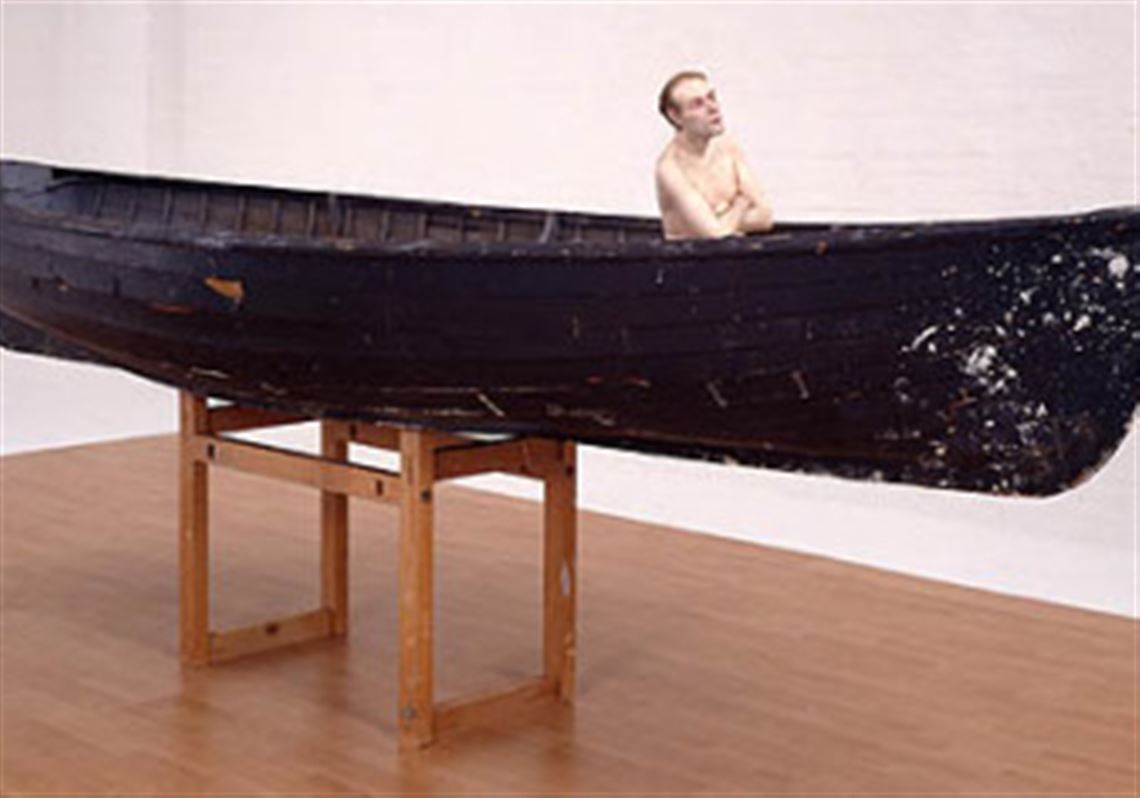"Dead Dad" is the title, and the subject, of the sculpture that catapulted Australian-born, London-based artist Ron Mueck to international recognition and media attention. Part of the controversial "Sensation" exhibition that premiered in 1997 at the Royal Academy of Arts, London, and traveled to the Brooklyn Museum of Art two years later, it was in company designed to stir if not to shock.
Also included in the show, for example, were Damien Hirst's formaldehyde-suspended 14-foot-long shark and the brothers Jake & Dinos Chapman's installation of hideously mutated little girls clothed only in running shoes. And it was artist Chris Ofili's depiction of "The Holy Virgin Mary," embellished with elephant dung, that spurred then-New York City Mayor Rudy Giuliani to threaten to withhold Brooklyn Museum funding.
Mueck's depiction of his late father, as with all of his work, is uncannily realistic, save for it being, at 40 inches in height, noticeably smaller than actual size. Lying on its back on the gallery floor, the naked figure was poignant and vulnerable, its eyes closed in final sleep and body stiff with rigor mortis.
While the edge has dulled on some of the exhibition's artists, Mueck (rhymes with "Buick") has had staying power, and today "Ron Mueck at The Andy Warhol," an exhibition of seven sculptures, opens at the North Shore museum.
Warhol director Thomas Sokolowski says he has admired Mueck's hyperealistic work for a long time. "He captures us with how amazing the technique is. And then, the scale. What is this? Is it art or is it reality?" Sokolowski says.
The figures show "absolutely intense emotion," Sokolowski says. "They're often nude, their faces scrunched up, extremely sad, bewildered, melancholic. Looking at them, we're all looking in a mirror."
- Where: The Andy Warhol Museum, 117 Sandusky St., North Shore
- When: Today through March 30.
- Hours: 10 a.m.-5 p.m. Tuesday through Sunday, until 10 p.m. Friday. Added hours 10 a.m. to 5 p.m. Christmas Eve and New Year's Eve.
- Admission: $15, seniors $9, students/children $8, half-price 5-10 p.m. Friday.
- Catalog: A bilingual book (English and French) published on the occasion of the Cartier Foundation, Paris, exhibition, is admirably suited to its subject. Besides a thoughtful essay and biographical information, there are fine full-color photographs of the exhibited works in progress in Mueck's studio and installed, as well as selected other figures and an illustrated oeuvre ($45, hard cover).
- Information: 412-237-8300 or www.warhol.org.
The first time I encountered Mueck was at the Hirshhorn Museum and Sculpture Garden in Washington, D.C. Stepping through a doorway into an otherwise empty gallery, my eyes shot to a mass of flesh across the room.
A nude, bald, very large man (in girth and in scale, at nearly 7 feet high seated) with a petulant expression occupied the room's corner, his head resting on one hand, his legs bent up in front of his ample stomach. "Untitled (Big Man)," part of the Hirshhorn's permanent collection, was so realistic -- the tones and suppleness of his skin, his nails, veins, all perfect -- that he seemed capable of rising and stomping out at any moment.
While I did note that he was anatomically correct, the voyeuristic aspect of the piece both invited and dissuaded intense scrutinizing, an element inherent in Mueck's figures.
Situation, emotion and scale are significant components of Mueck's impact, but it's the excruciatingly rendered detail that has garnered the most attention.
Physician John Quin, for example, writes in the British Medical Journal about Mueck's 8-foot-tall "Pregnant Woman: "We note the silvery callus on the woman's ankles, her linea nigra, the peau d'orange on the shins, the pigmented naevi. Her hair is clasped is an imperfect bun, her impatience with its ticklish irritation apparent. Her stretching arms exaggerate her gravid enormity. This is one big mamma, the mother of all ur-mothers. Such detail merits intense inspection, the textures invite palpation."
Of "Dead Dad," critic Craig Raine says in The Guardian (London): "Nothing is missing. Tendons, toenails, the direction of dark hair on the calves, the hazy pubes a little stationary mirage, the tidy graying hair, the polished, modest, uncircumcised cosh of the penis at four o'clock, which echoes the thumbs across the open, upturned palms."
To achieve this verisimilitude, Mueck goes through an exacting process. His works begin as plaster models, sometimes accompanied by drawings, through which he determines posture and scale. He then sculpts the pieces in clay, using metal and wire armatures in the larger ones. These he casts in fiberglass or silicon. Fleshy details are painted on. Resin eyeballs are added. Monofiliment strands representing head, facial and body hair are individually drilled (fiberglass) or punched (silicon) into the figures.
It's astonishing to learn that Mueck has never had formal art training. But he's obviously a keen observer. Add to that a knowledge of the tricks the entertainment and advertising professions use to penetrate the subconscious and generate emotional response, an understanding of the Gestalt involved, and an audaciousness towards subject matter sprung simultaneously from irreverence and awe, and you have an approach to the figure that is both unique and potent.
Mueck was born in 1958 in Melbourne, Australia, to German toy-maker emigres and began making toys as a child. He applied and developed his talents in the television and film worlds, where he created marionettes for children's television, worked in special effects and learned animatronic technology. After a brief stint with the movie industry in Los Angeles in 1986, he moved to England, where he worked with Jim Henson. At one time he owned a business that made models for the European advertising market.
In the mid-1990s, he created a Pinocchio figure for the acclaimed British painter Paula Rego, his mother-in-law, to use as a model in a Disney-themed series. The figure was exhibited with her paintings at the Hayward Gallery, London, where it caught the eye of Charles Saatchi, who commissioned other works, including "Dead Dad." The "Sensation" show was made up of artworks from the Saatchi collection.
Mueck's career has been in continuing ascent. In 2000-02 he was the fifth Associate Artist at the National Gallery, London (the first was Rego), an honor that gave him access to the collections and opportunity to develop his work. There, for example, the many idealized depictions of the infant Christ led to his more realistic, earthy explorations of newborns and pregnancy. His ceiling-high crouching "Boy" was exhibited in London's Millennium Dome in 2000 and at the 2001 Venice Biennale. And his 2006 exhibition at the Cartier Foundation in Paris broke attendance records; four of the five works created for that show have been brought to The Warhol.
Two reasons for their crowd-pleasing popularity are the accessibility of the works and the way they invite visitors to provide a narrative.
The monumental, sad looking woman "In Bed" isn't getting up, Sokolowski points out. "Has her lover left? Is she mourning her husband who died and left her with three children to raise? It could be your mom or sister lying in bed."
Sokolowski says that Mueck isn't about trickery, but that the artist wants viewers to look closely, in the way that Andy Warhol wanted viewers to experience his early films, which were made without a plot. Films were basically about plot, as Sokolowski says: "Will the good guy get killed? Will the guy get the girl?" Warhol asked the audience to slow down and look. "There's something wrong with this. It's not real. It's artificial."
Whatever you think of Mueck's work, chances are you won't walk by without looking. And then stopping to engage.
First Published: December 13, 2007, 10:00 a.m.


















